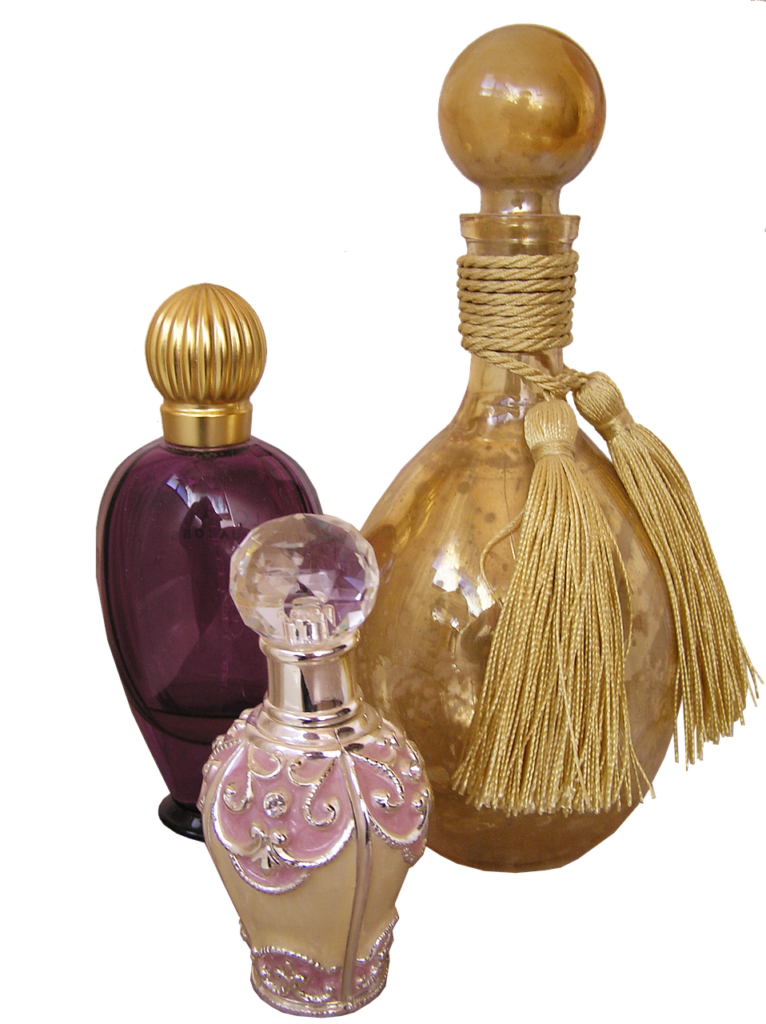Art of Perfume
Long tradition of perfumery
People have used perfume, oils and unguents on their bodies for thousands of years in lesser or greater amounts dependant on fashion whims.
What is perfume made from?
Perfume is made from about 78% to 95% of specially denatured ethyl alcohol and a remainder of fragrance.
- Perfume: between 22% to 48% of concentrated fragrance.
- Eau de Parfum (EDP): between 15 to 22% of concentrated fragrance.
- Eau de Toilette (EDT): between 8 to 15% concentrated fragrance.
- Eau de Cologne: between 2 to 4% of concentrated fragrance.
- Eau Fraiche: between 5 to 10% of concentrated fragrance.

In their composition we use natural essential oils and aromatic chemicals. Some of the most important essential oils and absolutes are myrrh, bay leaf, bergamot, cardamom, cedar wood, eucalyptus, frankincense, gardenia, geranium, jasmine, lavender, lemon, lilac, agarwood, lily of the valley, magnolia, oakmoss, neroli, orange, petitgrain, opoponax, orris, patchouli, vetiver, raspberry, rose, sage, sandalwood, rosemary, cipriol, tuberose, clary sage, vanilla, violet, yuzu, lotus, tagettes and ylang-ylang, ginger, cinnamon bark, shamama, gul hina, mantri, but more than 1.000 are used.
Most of the feminine notes include floral, oriental, chypre, fruity, fresh, clean and Diffusive floral-musky notes, musky and vanilla ingredients. While most of the masculine notes include lavender, fougere, oriental, chypre, citrus, green, marine, woody, musky and ambery elements.
Some of the most important chemicals are fruit of the great research taking place today. Woody-ambery chemicals like Iso E Super, Cedramber, Ambrox, Andrane, Ambrocenide, Polysantol, Firsantol, Nirvanol, Levosandol, Bacdanol, Sandalore, Javanol, Nor Limbanol, Trisamber, Vertofix Coeur, Woolfwood, Trimofix, Georgywood, Mysoral…
Musky chemicals such as Laevo-Muscone, Exaltolide, Habanolide, Globanone, Ambrettone, Isomuscone, Helvetolide, Aurelione, Exaltone, Hexadecanolide, Ethylen Brassilate, Ambrettolide, Nirvanolide, Vulcanolide, Muscenone, Exaltenone, Galaxolide, Moxalone…
Floral chemicals like Ethyl Linalool, Florol, Majantol, Super Muguet, Lilial, Bourgeonal, Paradisone, Myrrhone, Coranol, Hedione, Jasmine lactone…
Fresh marine chemicals such as Calone, Azurone…
Floral musky chemicals such as Cashmeran…
Green chemicals such as Cis-3-hexenol, Montaverdi, Vivaldie, Aladinate, Liffarome…
Tropical fruity chemicals such as Oxane, Thiohexanol, Aruscol, Passifloran…
The list would be endless but those chemicals mark the evolution of the industry of fragrances and flavours.
Typical animal products also used in perfume include:
- Amber gris (excrements of sperm whales), and chemicals related to it.
- Castoreum (secretion of the beaver).
- Musk (secrection of the male musk deer) and chemicals related to it.
- Civet (secretion from the civet cat).
All are used as fixatives and add an indefinable mystery to the smell at the same time.
